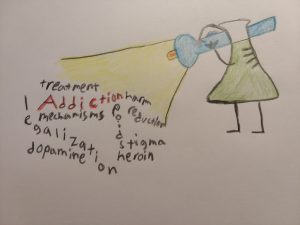Drugs have been a controversial part of American culture practically since its infancy. For centuries, scholars have argued about the role of alcohol all while Americans celebrate its use. Most people remember some sort of anti-drug education in their schools, whether it be the DARE program or public service announcements (PSAs). All of this anti-drug propaganda seems to have sparked a bit of a controversy, mainly surrounding whether or not these drugs are that harmful in the first place. While this is certainly a compelling debate, the answer cannot be reached without looking at the science behind these drugs.
In the article, A Schematic Overview of Addiction: Molecular Effects of Cocaine, Methamphetamine and Morphine on Limbic Neurons, researchers summarize the neurological effects of three major drugs: cocaine, methamphetamine, and opioids like morphine and heroine[ii].
Cocaine
Cocaine is a stimulant, much like the common drug caffeine. Like other stimulants, cocaine pushes the body into action, making us feel elevated, excited, focused, and eager to do things. Cocaine mainly interacts with dopamine, a chemical involved in the reward pathway. Dopamine is also responsible for the pleasurable feeling that comes from using drugs. In the normal brain, dopamine is released from the neuron and then binds to receptor on the next neuron. After it has done its job, dopamine gets picked by a transport protein. (The figure below outlines the basics of neurotransmitter reuptake). Cocaine prevents this last part from happening. Thus, dopamine’s affect is increased, leading to increased pleasure and reward.
Methamphetamine
Methamphetamine, or meth as it is more commonly known, is also a stimulant. However, there are few major differences between it and cocaine. For one thing, methamphetamine lasts a lot longer, mainly because it has a stronger effect on dopamine and other chemicals. Like cocaine, methamphetamine can block the transport proteins that take up dopamine, but it can trigger the release dopamine as well. Additionally, methamphetamine triggers the release of norepinephrine, another neurotransmitter involved in the reward pathway.
Heroin
Unlike methamphetamine and cocaine, heroin and other opioids are sedatives or depressants (like alcohol). These drugs generally produce a more relaxed feeling, rather than one of excitement and “let’s get things done”. Opioids still produce a strong sense of euphoria.
Your brain naturally has a set of opioid receptors. Normally, neurotransmitters like endorphin bind to these receptors. However, drugs like heroin can mimic these neurotransmitters and produce a similar response. These receptors are linked to special proteins called the g protein. When heroin or other opioids binds to the receptor, the alpha sub-unit of the g protein breaks away. This process is aided by GTP. Opioids increase the activity of GTP.
Additionally, these g proteins are linked to various calcium and potassium channels within the neuron. (For a brief summary on the g protein, click here). When activated, the g protein helps close these channels. This makes the inside of the neuron more negative in terms of charge, preventing it from firing. This is what causes the sedative effect of opioids. (Note: this occurs because opioids interact with a specific type of g protein. A list of the different types of g proteins can be found here).
Why does this matter in the debate?
Whether a depressant like heroin or a stimulant like cocaine, all drugs trigger the release of dopamine. While dopamine is capable of exciting a neuron, in this case it mostly inhibits the inhibitory neurons. Think of this like a double negative. Inhibition of inhibition leads to excitation. A side effect of this excitation is the release of glutamate and the subsequent recruitment of AMPA receptors. This helps our brain remember where the pleasurable stimulus came from and makes us more likely to seek it again. This is what leads to addiction.
Addiction, in a certain light, is more or less a mechanism of how substances take over the brain, controlling wants and cravings for the substance. Addiction can be a terrible thing. It is also incredibly complex and difficult to treat, which is why some advocates for legalization/decriminalization of drugs have simply given up and said “let them do it.” If drugs like methamphetamine, cocaine, and heroin are going to be legalized, then they need to be deemed safe to use. The safety of this drugs is something the researchers acknowledge is not really well known[v]. There is some information. Both cocaine and methamphetamine can lead to heart problems, and potentially lead to a state of psychosis similar to schizophrenia. A lot of the dangers of using these drugs comes from impurities. Dealers often mix drugs like heroin with other illicit drugs or substances to either cut cost or alter the affect. These substances often have terrible side effects and can exacerbate the side effects of the original drug. Legalizing drugs is theorized to cut down on these impurities and the dangers associated with them. Now, how much of the danger of using illegal drugs comes from impurities and how much comes from the drugs themselves is unknown at this time.
Knowing the science on addiction really showcases it as the complex issue that it is. There are multiple chemical pathways of addiction. It affects nearly every area of the brain, and in different ways. Looking at the science behind these drugs and addiction in general shifts the debate from vilifying drugs and those who are addicted to them to discussing how to properly solve the problem of addiction.
[i] Artstract by Mitzi Probst.
[ii] https://moodle.cord.edu/pluginfile.php/818256/mod_resource/content/0/Overview%20of%20addiction%202019.pdf
[iii] https://www.ck12.org/biology/drugs-and-the-nervous-system/lesson/Drugs-and-the-Nervous-System-Advanced-BIO-ADV/
[iv] https://www.christian.org.uk/news/surge-free-needles-belfast-heroin-addicts/
[v] https://moodle.cord.edu/pluginfile.php/818256/mod_resource/content/0/Overview%20of%20addiction%202019.pdf

